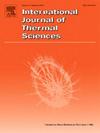Schoen 's I-WP(R) TPMS结构多孔材料的导热性能
IF 5
2区 工程技术
Q1 ENGINEERING, MECHANICAL
International Journal of Thermal Sciences
Pub Date : 2025-07-21
DOI:10.1016/j.ijthermalsci.2025.110138
引用次数: 0
摘要
本文基于Schoen的I-WP(R)三周期极小表面(TPMS)描述了正交异性材料的热性能。TPMS结构类似于一个矩阵,由相同的细胞组成,在所有方向上都有严格的周期性。基于Schoen’s I-WP(R),得到了确定材料有效导热系数与孔隙率、相对厚度、原始材料导热系数和热流方向的新的统一依赖关系。考虑到具有Schoen 's I-WP(R)结构的多孔材料中孔隙的形状和排列,确定了导热张量的经验系数。利用研究过程中得到的方程,可以通过改变结构的特征尺寸来设计具有指定导热系数值的多孔材料。此外,所研究的Schoen 's I-WP(R)最小表面表现出正交异性,导致不同方向的导热系数不同。这可以应用于与非正交散热相关的某些项目任务,例如热电工程,航空或电子。在本研究中,采用ANSYS Steady-State Thermal中实现的数值有限元方法来确定热性能。Schoen的I-WP(R) TPMS的几何结构发表在Mendeley门户网站上。本文章由计算机程序翻译,如有差异,请以英文原文为准。
Thermal conductivity of porous materials with Schoen’s I-WP(R) TPMS structure
The article describes the thermal properties of orthotropic materials based on Schoen’s I-WP(R) triple periodic minimal surface (TPMS). The TPMS structure resembles a matrix and consists of identical cells, strictly periodic in all directions. New unified dependencies for determining the effective thermal conductivity of materials based on Schoen’s I-WP(R) with respect to porosity, relative thickness, thermal conductivity of the original materials, and the direction of heat flow were obtained in the study. Empirical coefficients for the thermal conductivity tensor have been determined, taking into account the shape and arrangement of pores in porous materials with the Schoen’s I-WP(R) structure. By using the equations obtained during the research, it is possible to design porous materials with specified thermal conductivity values by altering the characteristic dimensions of the structure. Additionally, the investigated Schoen’s I-WP(R) minimal surface exhibits orthotropic properties, resulting in different thermal conductivity in various directions. This can be applied in certain project tasks related to non-orthogonal heat dissipation, such as in thermal power engineering, aviation or electronics. In this study, a numerical finite element method implemented in ANSYS Steady-State Thermal was used to determine the thermal properties. The geometry of Schoen’s I-WP(R) TPMS is published on the Mendeley portal.
求助全文
通过发布文献求助,成功后即可免费获取论文全文。
去求助
来源期刊

International Journal of Thermal Sciences
工程技术-工程:机械
CiteScore
8.10
自引率
11.10%
发文量
531
审稿时长
55 days
期刊介绍:
The International Journal of Thermal Sciences is a journal devoted to the publication of fundamental studies on the physics of transfer processes in general, with an emphasis on thermal aspects and also applied research on various processes, energy systems and the environment. Articles are published in English and French, and are subject to peer review.
The fundamental subjects considered within the scope of the journal are:
* Heat and relevant mass transfer at all scales (nano, micro and macro) and in all types of material (heterogeneous, composites, biological,...) and fluid flow
* Forced, natural or mixed convection in reactive or non-reactive media
* Single or multi–phase fluid flow with or without phase change
* Near–and far–field radiative heat transfer
* Combined modes of heat transfer in complex systems (for example, plasmas, biological, geological,...)
* Multiscale modelling
The applied research topics include:
* Heat exchangers, heat pipes, cooling processes
* Transport phenomena taking place in industrial processes (chemical, food and agricultural, metallurgical, space and aeronautical, automobile industries)
* Nano–and micro–technology for energy, space, biosystems and devices
* Heat transport analysis in advanced systems
* Impact of energy–related processes on environment, and emerging energy systems
The study of thermophysical properties of materials and fluids, thermal measurement techniques, inverse methods, and the developments of experimental methods are within the scope of the International Journal of Thermal Sciences which also covers the modelling, and numerical methods applied to thermal transfer.
 求助内容:
求助内容: 应助结果提醒方式:
应助结果提醒方式:


